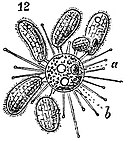File:EB1911 Infusoria - Suctoria.jpg
Appearance

Size of this preview: 269 × 599 pixels. Other resolutions: 108 × 240 pixels | 215 × 480 pixels | 776 × 1,727 pixels.
Original file (776 × 1,727 pixels, file size: 590 KB, MIME type: image/jpeg)
File history
Click on a date/time to view the file as it appeared at that time.
| Date/Time | Thumbnail | Dimensions | User | Comment | |
|---|---|---|---|---|---|
| current | 16:22, 16 August 2018 |  | 776 × 1,727 (590 KB) | Bob Burkhardt | {{Information |description ={{en|1=Suctoria (in all a, meganucleus; b, contractile vacuole): 1, Rhyncheta cyclopum, Zenker; only a single tentacle and that suctorial; epizoic on Cyclops. 2, Sphaerophrya urostylae, Maupas; normal adult; parasitic in Ciliate Urostyla. 3, The same dividing by transverse fission, the anterior moiety with temporarily developed cilia. 4, 5, 6, Sphaerophrya stentorea, Maupas. Parasitic in Stentor, and at one time mistaken for its young. 7, Trichophrya epistyl... |
File usage
The following 2 pages use this file:


